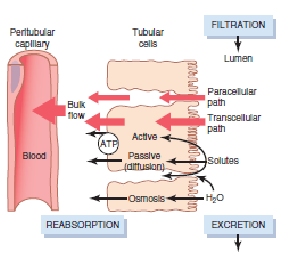
Renal Tubular Reabsorption and Secretion
As the glomerular filtrate enters the renal tubules, it flows sequentially through the successive parts of the tubule— the proximal tubule, the loop of Henle, the distal tubule, the collecting tubule, and, finally, the collecting duct— before it is excreted as urine. Along this course, some substances are selectively reabsorbed from the tubules back into the blood, whereas others are secreted from the blood into the tubular lumen. Eventually, the urine that is formed and all the substances in the urine represent the sum of three basic renal processes—glomerular filtration, tubular reabsorption, and tubular secretion. For many substances, tubular reabsorption plays a much more important role than secretion in determining the final urinary excretion rate. However, tubular secretion accounts for significant amounts of potassium ions, hydrogen ions, and a few other substances that appear in the urine.All plasma constituents except the plasma proteins are indiscriminately filtered together through the glomerular capillaries. In addition to waste products and excess materials that the body must eliminate, the filtered fluid contains nutrients, electrolytes, and other substances that the body cannot afford to lose in the urine. Indeed, through ongoing glomerular filtration, greater quantities of these materials are filtered per day than are even present in the entire body. The essential materials that are filtered are returned to the blood by tubular reabsorption, the discrete transfer of substances from the tubular lumen into the peritubular capillaries.
By providing a second route of entry into the tubules for selected substances, tubular secretion, the discrete transfer of substances from the peritubular capillaries into the tubular lumen, is a supplemental mechanism that hastens elimination of these compounds from the body. Anything that gains entry to the tubular fluid, whetherby glomerular filtration or tubular secretion, and fails to be reabsorbed is eliminated in the urine.
Students will learn at the end of the lesson;
TUBULAR REABSORPTION MECHANISMS
TUBULAR SECRETION MECHANISMS
REABSORPTION AND SECRETION OF DIFFERENT SUBSTANCES ALONG DIFFERENT PARTS OF THE NEPHRON
REGULATION OF TUBULAR REABSORPTION AND SECRETION
USE OF CLEARANCE METHODS TO QUANTIFY KIDNEY FUNCTION
CALCULATION OF TUBULAR REABSORPTION OR SECRETION FROM RENAL CLEARANCES


